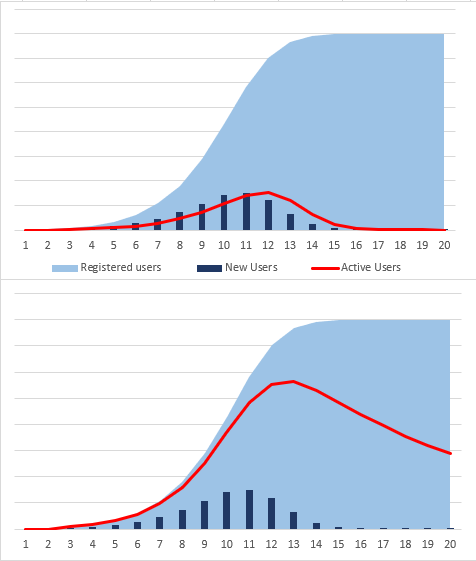- ARPDAUPosted 13 years ago
- What’s an impressive conversion rate? And other stats updatesPosted 13 years ago
- Your quick guide to metricsPosted 13 years ago
Retention rate, churn and duration
 Retention rate, churn and duration all measure the same thing: how effective are you at getting users to come back to your game.
Retention rate, churn and duration all measure the same thing: how effective are you at getting users to come back to your game.
Regular readers will know that I view retention as the most important of the three ARM constituents (Acquisition, Retention, Monetisation).
The relationship between retention rate, churn and duration is as follows:
- Retention rate is defined as what percentage of the people who played your game in month 1 are still playing in month 2
- Churn is one minus the retention rate as a percentage (i.e. 1-R%). If 80% of your users returned from month 1 to month 2, you would have a churn of 20%. The reason to calculate churn this way is that it ignores the distorting effect of new users
- Duration is the reciprocal of churn (i.e. 1/churn). If your churn is 20%, your duration – the average number of months a player stays with you – is 5 months.
Note that retention rates, churn and duration are more nebulous concepts in the free-to-play world than in a subscription businesses. A subscriber who cancels his subscription is generally gone. The effort of cancelling is, intentionally, sufficiently high that it takes a real effort to leave, and consequently it is unlikely that that subscriber is will return.
Free to play games aim to minimise friction. They make it easy for users to keep spending. A user might spend a little in month one, a lot in month two (counting as a retained customer), nothing in month three (counting as a churned customer) and then a little again in month four (potentially counting as a new customer for the purposes of calculating retention.
I emphasise, therefore, that this spreadsheet is a tool. It is an approximation designed to help you tweak your funnel to drive revenues. Its simplicity is its strength, and its weakness. (Having said that, I am always keen to get feedback on ways I could improve it).
Benchmarks
An appropriate benchmark for duration is somewhere between two months and six months. That implies a churn of 15%-50% and a retention rate of 50-85%. According to flurry, for iOS and Android apps, 24% of customers continue using after three months. After 6 months, this percent shrinks to 14%, and, by 12 months, only 4% are left.
DeltaDNA says that typical day one retention rates are 20-40%. Only 16% of games have retention rate of over 50% (September 2014, source: Nick Parker on Twitter) Everyplay’s data suggests that ARPU increases dramatically among players who spend more than ten hours playing a game (October 2014, source: gi.biz) Raf Keustermanns of Plumbee also stated at the Social Games Summit 2011 that any dev should expect to lose 96% of their user base within 12 months. Playnomics have found that approximately 85% of players do not return after the first day.
Your game design can have an enormous influence on the retention rate. According to Playnomics;
- users that are brought back into the game within two days of their first session play 334% more overall
- players who do not churn play for twice as long on their first day
- players who carry out more actions in a game session are retained for longer.
Facebook games
Reports suggest that Zynga has a retention rate of only 50%. Given its success, I’m inclined to believe that this is the retention rate for an individual game, not across the whole of Zynga. Zynga gives you two months on any given game to see if you will spend. If you don’t, Zynga tries to move you out to a different game to see if you are more inclined to spend there. It is a sensible strategy if you have a portfolio of online games.
Kixeye has an average duration of 7 months for daily active users, which suggests a retention rate of 85%.
iOS
Giordano Bruno Contestabile of PopCap said during his GDC talk in March 2012 that 7-day retention on iOS for Bejeweled was double that of Facebook.
Individual titles
- Subway Surfers has a 30-day retention rate of 70%. (source: Forbes, 06/05/2013)
PC
- PC Online title Jagged Alliance Online had a D1 retention of 35%, but below 15% for week 1. 3-5% of people played for “months and sometimes years, once they got past the initial phase.” (Source: GAMESbrief, 28/09/2015)
- PC Online title AErena also had D1 retention of 35%, but below 15% for week 1 on PC. On mobile, it had 25% D1 and less 10% in week one. (Source: GAMESbrief, 28/09/2015)












